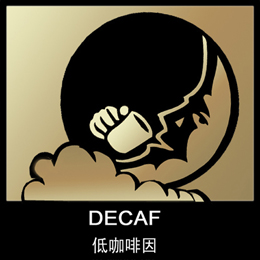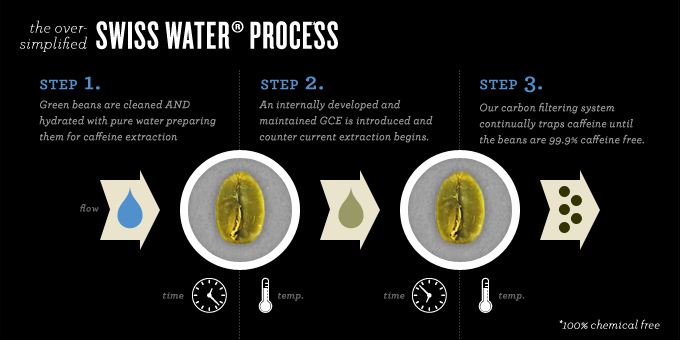WE’RE ABOUT ECOLOGY and SCIENCE
Our ecology-friendly water decaffeination process uses simple science to remove caffeine from green coffee beans. Still, it’s a bit more complicated than your average high school science class, so in short let’s just say you’re getting all the things you love about coffee without the caffeine. But let’s consult our fancy flow chart for a bit more detail.
People drink decaffeinated coffee for a variety of reasons. However, it’s important to know that decaffeination methods vary. Most use chemical solvents such as methylene chloride or ethyl acetate to strip caffeine molecules from the green coffee bean. And some leave behind more caffeine than you would think.
Alternatively, the proprietary Swiss Water® Process uses water from the pristine environment of the coast mountains of British Columbia, Canada to gently remove the caffeine until the coffee beans are 99.9% caffeine-free, while maintaining the bean’s distinctive origin and flavor characteristics. It’s decaffeinated coffee without compromise.
How do you know how your coffee is decaffeinated? This is difficult unless the coffee package labeling identifies the method or process. Coffee brands using Swiss Water® Process communicate their decaffeination choice by use of the Swiss Water® Process seal or wordmark. It’s a way to help you know.
ABOUT COFFEE and CAFFEINE
Caffeine is a natural occurring substance that is present in the leaves, seeds and fruits of more than sixty different plant species worldwide. Many food and beverage products made from these plants inherently contain varying amounts of caffeine
A typical 12oz cup of caffeinated coffee contains between 120 mg to 180 mg of caffeine while a decaffeinated cup of coffee the same size has caffeine levels anywhere between 2 mg and 6 mg. The blend composition, extraction rates, water temperature, grind and roast can all minutely affect the final caffeine levels found in decaf coffee and accounts for the difference.
Espresso has similar caffeine content on a volume basis to brewed coffee. Therefore, decaf espresso will have only trace amounts of caffeine, similar to the caffeine content of brewed decaf.
DECAFFEINATION STANDARDS
In the US, decaffeinated coffee has a guideline that requires 97% of the caffeine to be removed from a green coffee bean. Being a guideline, as opposed to a standard, provides roasters more flexibility in terms of the percent of caffeine removed.
However, in Canada and the international community, 99.9% caffeine-free is the recognized standard for decaffeinated coffee based on the maximum allowable caffeine level remaining in a decaffeinated green coffee bean.
Coffee decaffeinated using the environment-friendly Swiss Water® Process undergoes regular caffeine level audits to ensure compliance to 99.9% caffeine-free. We take pride in setting high quality standards and have a Certificate of Analysis (COA) for every batch of beans we decaffeinate with our water decaffeination process.
Swiss Water Decaffeination Process
The Swiss Water® Process is a taste-driven, 100% chemical free, water decaffeination process that delivers to today’s consumer expectations. Certified organic by OCIA, it is used by premium roasters and retailers and demanded by informed and discerning decaf drinkers.
We use Six Sigma Methodology to continuously measure and improve our process, and Quality Management Systems to maintain and consistently deliver quality product. Once Swiss Water® Process green decaf beans are roasted, the result is a full bodied, flavorful cup of coffee — decaf coffee, without compromise.
Here’s a brief description of the process:
When the green coffee beans arrive, they are cleaned and pre-soaked using water which hydrates the beans and prepares them for caffeine extraction.
Green Coffee Extract (GCE) is important to our process. GCE was created by taking a number of containers of Arabica coffee beans and soaking them in water until the caffeine migrated from the beans. We then put the GCE through a carbon filter to capture the caffeine resulting in a water that is saturated with soluble coffee solids less the caffeine.
With this GCE in place, new green coffee is placed in the GCE after a brief pre-soak (to expand the coffee and make it ready for caffeine extraction).
The concentration level and the stability of the soluble coffee components in the GCE is maintained at equilibrium with the green coffee beans – critical to our process.
By carefully monitoring time, temperature, and flow, we are able to optimize the high pressure caffeine specific driving force between the bean and the GCE. The result is a net extractive process whereby only caffeine is removed, leaving the coffee’s unique origin flavor characteristics intact.
The GCE, now saturated with caffeine, moves from the bean holding tanks to our proprietary carbon filtering system which is designed to specifically trap the caffeine molecules and nothing else, thereby maintaining and protecting the concentration level of the soluble coffee components in the GCE. This is a continuous process in which the GCE flows from the carbon filtration system back to the extraction columns until the coffee beans are 99.9% caffeine free. This takes approx 8-10 hours and is closely monitored and controlled by our skilled operators.
When the carbon is saturated with caffeine it moves to the carbon regeneration furnace where the caffeine is burned away and the carbon revitalized based on our fractal geometry carbon specifications.
Virgin carbon is added post-furnace at the attrition rate. Attrition is defined as carbon that no longer meets our strict quality standards.
Our GCE is continuously maintained by our water-washed carbon solid recovery program.
After the beans are decaffeinated, they are removed from the holding tanks, dried, bagged, tagged, and ready to be roasted.
DECAF (Swiss Water Processed)

Source:
http://www.swisswater.com/consumer/swiss-water-process
Related articles you might like:
Follow us on WeChat: aluokecoffee
关注我们的公众微信: 阿罗科咖啡




